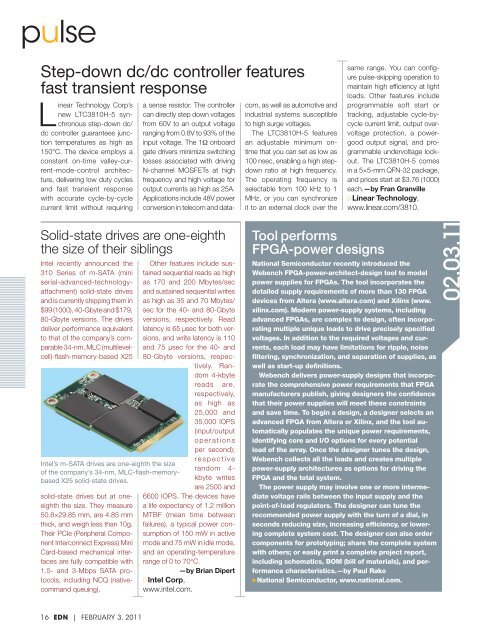VOICE OF THE ENGINEER - ElectronicsAndBooks
VOICE OF THE ENGINEER - ElectronicsAndBooks
VOICE OF THE ENGINEER - ElectronicsAndBooks
- No tags were found...
You also want an ePaper? Increase the reach of your titles
YUMPU automatically turns print PDFs into web optimized ePapers that Google loves.
pulseStep-down dc/dc controller featuresfast transient responseLinear Technology Corp’snew LTC3810H-5 synchronousstep-down dc/dc controller guarantees junctiontemperatures as high as150°C. The device employs aconstant on-time valley-current-mode-controlarchitecture,delivering low duty cyclesand fast transient responsewith accurate cycle-by-cyclecurrent limit without requiringa sense resistor. The controllercan directly step down voltagesfrom 60V to an output voltageranging from 0.8V to 93% of theinput voltage. The 1Ω onboardgate drivers minimize switchinglosses associated with drivingN-channel MOSFETs at highfrequency and high voltage foroutput currents as high as 25A.Applications include 48V powerconversion in telecom and datacom,as well as automotive andindustrial systems susceptibleto high surge voltages.The LTC3810H-5 featuresan adjustable minimum ontimethat you can set as low as100 nsec, enabling a high stepdownratio at high frequency.The operating frequency isselectable from 100 kHz to 1MHz, or you can synchronizeit to an external clock over thesame range. You can confi g-ure pulse-skipping operation tomaintain high effi ciency at lightloads. Other features includeprogrammable soft start ortracking, adjustable cycle-bycyclecurrent limit, output overvoltageprotection, a powergoodoutput signal, and programmableundervoltage lockout.The LTC3810H-5 comesin a 5×5-mm QFN-32 package,and prices start at $3.76 (1000)each.—by Fran Granville▷Linear Technology,www.linear.com/3810.Solid-state drives are one-eighththe size of their siblingsIntel recently announced the310 Series of m-SATA (miniserial-advanced-technologyattachment)solid-state drivesand is currently shipping them in$99 (1000), 40-Gbyte and $179,80-Gbyte versions. The drivesdeliver performance equivalentto that of the company’s comparable34-nm, MLC (multilevelcell)-flash-memory-based X25Intel’s m-SATA drives are one-eighth the sizeof the company’s 34-nm, MLC-flash-memorybasedX25 solid-state drives.solid-state drives but at oneeighththe size. They measure50.8×29.85 mm, are 4.85 mmthick, and weigh less than 10g.Their PCIe (Peripheral ComponentInterconnect Express) MiniCard-based mechanical interfacesare fully compatible with1.5- and 3-Mbps SATA protocols,including NCQ (nativecommandqueuing).Other features include sustainedsequential reads as highas 170 and 200 Mbytes/secand sustained sequential writesas high as 35 and 70 Mbytes/sec for the 40- and 80-Gbyteversions, respectively. Readlatency is 65 μsec for both versions,and write latency is 110and 75 μsec for the 40- and80-Gbyte versions, respectively.Random4-kbytereads are,respectively,as high as25,000 and35,000 IOPS(input/outputoperationsper second);respectiverandom 4-kbyte writesare 2500 and6600 IOPS. The devices havea life expectancy of 1.2 millionMTBF (mean time betweenfailures), a typical power consumptionof 150 mW in activemode and 75 mW in idle mode,and an operating-temperaturerange of 0 to 70°C.—by Brian Dipert▷Intel Corp,www.intel.com.Tool performsFPGA-power designsNational Semiconductor recently introduced theWebench FPGA-power-architect-design tool to modelpower supplies for FPGAs. The tool incorporates thedetailed supply requirements of more than 130 FPGAdevices from Altera (www.altera.com) and Xilinx (www.xilinx.com). Modern power-supply systems, includingadvanced FPGAs, are complex to design, often incorporatingmultiple unique loads to drive precisely specifiedvoltages. In addition to the required voltages and currents,each load may have limitations for ripple, noisefiltering, synchronization, and separation of supplies, aswell as start-up definitions.Webench delivers power-supply designs that incorporatethe comprehensive power requirements that FPGAmanufacturers publish, giving designers the confidencethat their power supplies will meet these constraintsand save time. To begin a design, a designer selects anadvanced FPGA from Altera or Xilinx, and the tool automaticallypopulates the unique power requirements,identifying core and I/O options for every potentialload of the array. Once the designer tunes the design,Webench collects all the loads and creates multiplepower-supply architectures as options for driving theFPGA and the total system.The power supply may involve one or more intermediatevoltage rails between the input supply and thepoint-of-load regulators. The designer can tune therecommended power supply with the turn of a dial, inseconds reducing size, increasing efficiency, or loweringcomplete system cost. The designer can also ordercomponents for prototyping; share the complete systemwith others; or easily print a complete project report,including schematics, BOM (bill of materials), and performancecharacteristics.—by Paul Rako▶National Semiconductor, www.national.com.02.03.1116 EDN | FEBRUARY 3, 2011






![[270].pdf 37407KB Sep 02 2010 09:55:57 AM - ElectronicsAndBooks](https://img.yumpu.com/50350834/1/185x260/270pdf-37407kb-sep-02-2010-095557-am-electronicsandbooks.jpg?quality=85)
![draaien, A Viruly 1935 OCR c20130324 [320]. - ElectronicsAndBooks](https://img.yumpu.com/49957773/1/190x252/draaien-a-viruly-1935-ocr-c20130324-320-electronicsandbooks.jpg?quality=85)



![20051110 c20051031 [105].pdf 35001KB Feb 18 2009 08:46:32 PM](https://img.yumpu.com/48687202/1/190x253/20051110-c20051031-105pdf-35001kb-feb-18-2009-084632-pm.jpg?quality=85)




